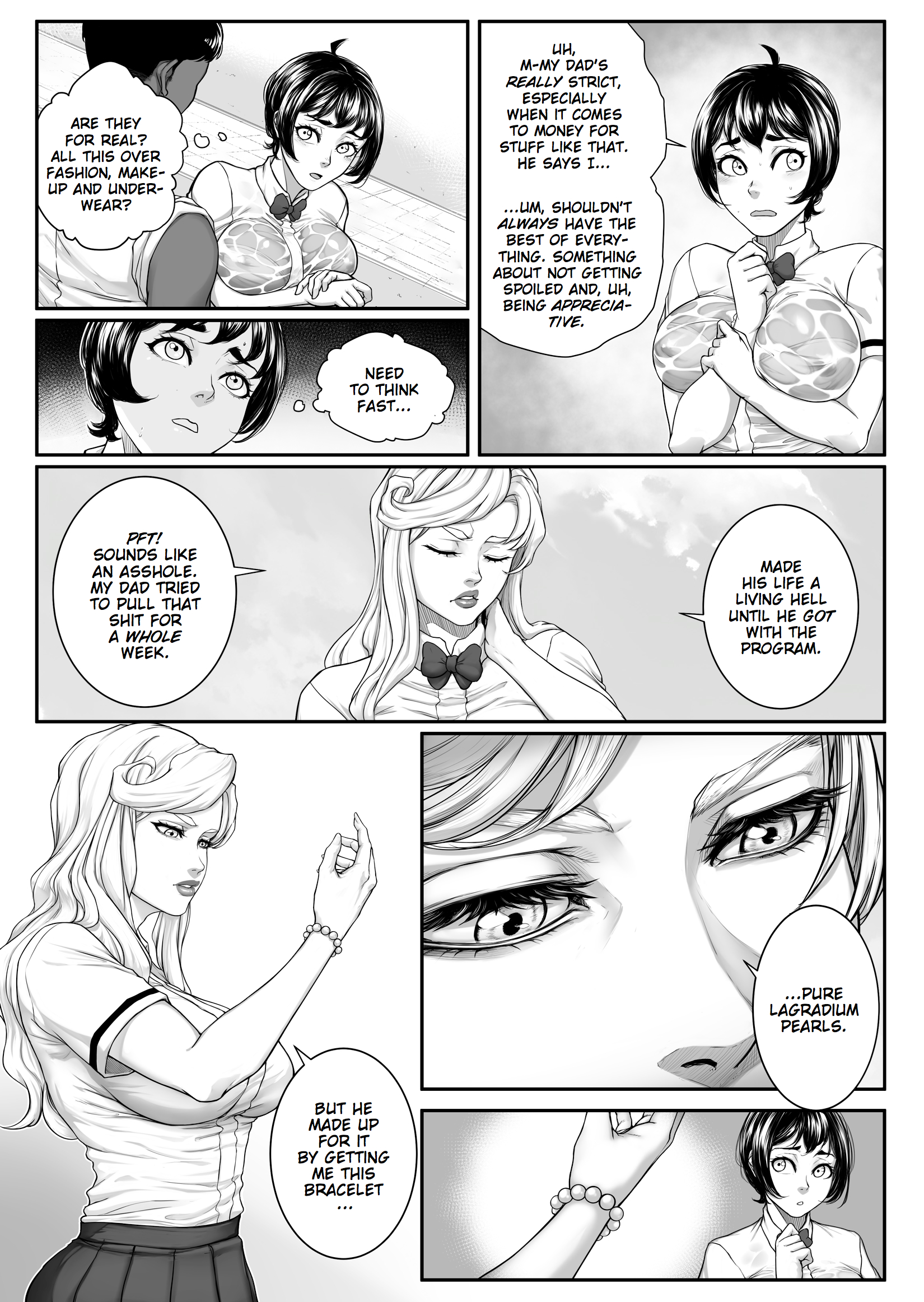Chapter 19, Page 12
The following is an abridged article from World News, a bi-weekly periodical featuring coverage on current affairs, politics, business, health, science and entertainment. [Article originally published one year ago.]
BLOOD PEARLS AND THE LUXURY OF WAR
By Hugo Dewit
It had been predicted that the once-booming pearl industry would be on the verge of collapse within a decade. Two years ago it happened—the market toppled and even the once-illusive natural pearls have become undesirable and passé to wealthy clientele. Last year the global pearl market reported a 70% decline, the largest in history.
What’s behind this abrupt shift? New advancements in pearl production have oversaturated the market, adding unprecedented affordability that has effectively devalued the industry. Cultured pearls are produced to such perfection that they’re indiscernible from natural ones and, due to recent technology, virtually impossible to tell apart by the even most thorough x-ray examination. The mass production of these cultured pearls—between the speed at which they can now be produced and the flawless level of quality—has made the valuable gems as easily obtainable and inexpensive as imitation pearls once were.
But where one industry declines, another rises. Nine months ago Karlsson Luxuries released the first in a line of “pearl” jewelry produced entirely of lagradium. Though not actual pearls, the lagradium is laser cut to form perfectly rounded spheres, which are then turned into earrings, necklaces, and bracelets—hot-ticket items that have garnered the attention and interest of the ultra-rich.
What makes this jewelry so desirable is the lagradium’s extreme rarity—a metal so scarce it’s only been found in one country. Lagradium exudes an undeniably exquisite luster and, when laser cut into the shape of a spherical pearl, possesses a surface quality that notable jewelry expert, Emert Rohn, called “one of the most magnificent creations on Earth.”
All known lagradium mines are located in Bwansuri, a nation currently embroiled in a longstanding civil war that has claimed nearly 30% of the country’s population over the last seven years. The conflict has left Bwansuri so fractured that entire regions have been overtaken by guerrilla factions and power-hungry warlords. Lagradium is now being sold to finance the ongoing war, with rival militias fighting for control of the mines and adding to an ever-increasing death toll. Outside of being manufactured into jewelry, lagradium has little use—but that may soon change. The metal’s high temperature stability, thermal conductivity, corrosion resistance, and low permeability has attracted the attention of aerospace companies, who are eyeing lagradium’s potential for use in next-generation rocket engines and thermal protection systems.
Not everyone is so impressed. Karlsson Luxuries’ lagradium products are being criticized by some as “blood pearls” while several human rights organizations are calling for a boycott of all lagradium goods. Yet the pearls’ rarity and growing infamy have only served to fuel interest from the wealthiest corners of the fashionably-inclined. Lagradium pearls are now in high-demand, carrying a price tag of one million dollars per pearl. If you think that’s a hard sell, think again. Karlsson Luxuries has been unable to keep up with the demand, forcing buyers onto waiting lists that stretch well into next year. The latest status symbol for the exceedingly affluent, lagradium’s future may depend less on demand and more on how much mining can be done as war ravages a country.
Danger Zone One. Story by Midnight. Art by Salaiix.























Her father turned himself around.
Maybe in time she will do the same.
Her dad sounds like a wimp :p
Having briefly gone to a private school with rich entitled kids, Mora’s dialogue here is on point. Most parents basically paid off/bribed their own kids to not be terrors and it only worked a quarter of the time.
I’m guessing 14 pearls make up that bracelet, so $14 million for it?
I got 15 or 16 allowing for completion of the circle. Probably 15 if there is a clasp; 16, possibly 17 if it is contiguous and slid on over the hand.
I’m curious as to where in the world this fractured nation of Bwansuri is located. A webcomic like this one could really show its stuff with the inclusion of an atlas. I think it would be awesome.
It sounds like a grimdark Wakanda to me.
I’m not sure DZO is set in a very close analogue to our world, but war-torn countries with important minerals are in our world found in Africa. You can look up blood minerals if you’d like but it’s pretty much exactly what was described above, except with real elements (notably Ta) desirable for their function instead of Lagradium desirable just because it’s expensive. I think it has also happened quite a bit with plain old gold.
Well done! You just reinforced Reena’s fake-dad’s point about being a spoilt bitch
People like Mora like to bully others to make themselves feel
like they matter.